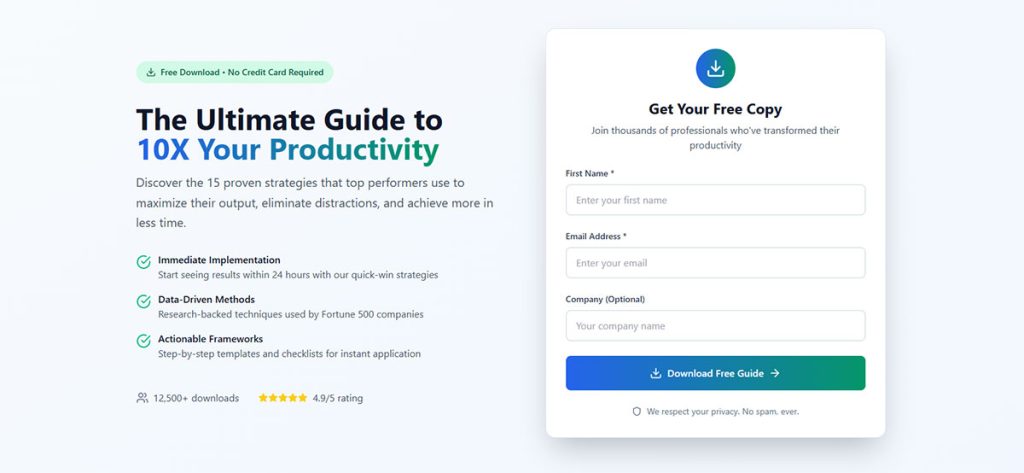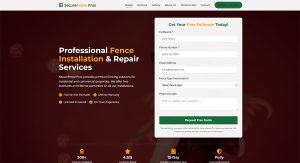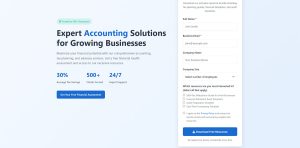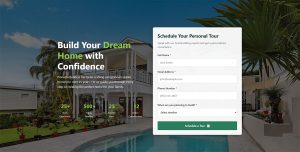Your phone should be ringing. It isn’t. Meanwhile, competitors down the road have jobs booked three weeks out. The difference? Lead generation for fence contractors that actually works. Most fencing…
Table of Contents
Website forms convert 23% of visitors into leads when optimized correctly. Most businesses waste this massive opportunity through poor design and placement decisions.
Learning how to generate B2C leads using website forms transforms casual browsers into paying customers. Consumer audiences require different approaches than B2B prospects. They make faster decisions but need stronger emotional triggers.
This guide reveals proven strategies for:
- Strategic form placement that captures attention without annoying visitors
- Lead magnet creation that consumers actually want
- Mobile optimization techniques for smartphone users
- Conversion rate optimization through systematic testing
- Follow-up automation that nurtures prospects into customers
Transform your website into a lead generation machine. The techniques inside work for e-commerce stores, service businesses, and consumer brands of all sizes.
Strategic Placement of Lead Generation Forms
Form placement determines success. Poor positioning kills conversions before visitors even see your offer.
Homepage Form Placement Best Practices
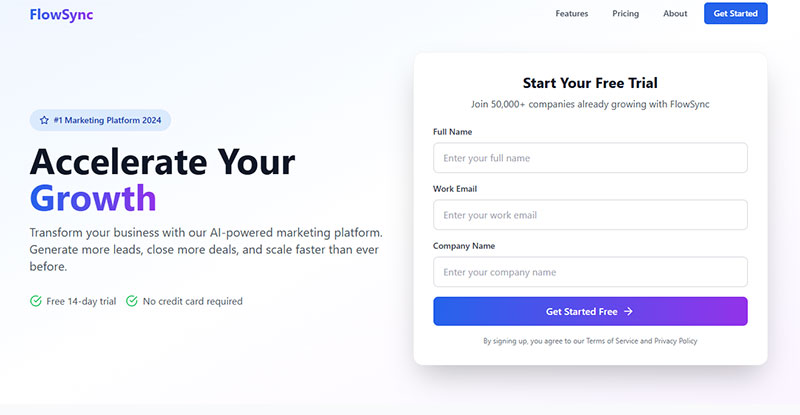
Above-the-fold positioning captures immediate attention. Place your primary lead generation form where visitors land first. Hero sections work best for consumer brands.
85% of marketers say lead generation is their top measure in 2024, making strategic placement critical for business growth. 61% of marketers face the biggest challenge in generating leads, often due to poor form positioning.
Skip complex navigation menus. Focus on one clear action.
Sidebar integration keeps forms visible during browsing. Sticky sidebars follow users down the page. This placement works for blogs and product catalogs where people scroll extensively.
Research shows that 76% of users will scroll if a page has a scroll bar, while 22% will scroll to the bottom. Test sidebar forms against floating elements. Some audiences prefer fixed positioning over scrolling sidebars.
Footer placement targets engaged visitors. People who scroll to the bottom show genuine interest. Footer forms catch browsers ready to take action after consuming your content.
Newsletter signups perform well in footers. Add exclusive offers to boost signup rates.
Product and Service Page Form Integration
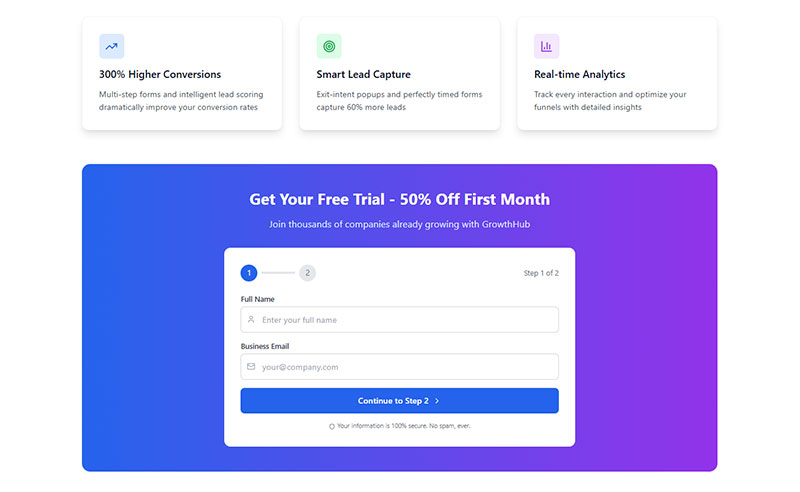
Place forms near product descriptions while purchase intent peaks. Position them after key benefits but before overwhelming technical details.
Professional services boast an impressive 9.3% conversion rate, while B2B technology and real estate record the lowest 1.7% conversion rate. Short forms work better on product pages. Ask for email and name only.
Call-to-action buttons should stand out visually. Use contrasting colors that pop against your design. Test different button sizes and shapes to find what converts best.
Conversions can skyrocket by as much as 300% by using multi-step forms. Button text matters enormously. “Get My Discount” outperforms generic “Submit” buttons.
Exit-intent popup forms capture leaving visitors. These popup forms trigger when mouse movement suggests abandonment. Cart abandonment popups have an average conversion rate of 17.12%, while exit-intent popups typically convert an additional 2 to 4% of website visitors.
Well-designed and properly timed popups can lead to conversion rates as high as 60%. Time delays prevent annoyance. Wait at least 30 seconds before showing popups to new visitors.
Blog and Content Page Form Strategy
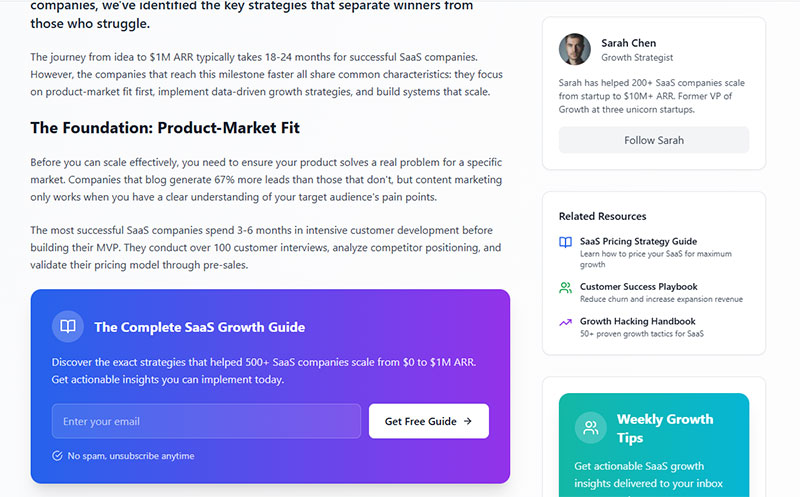
In-content placement works during engagement peaks. Insert forms after valuable paragraphs where readers feel satisfied but want more information.
Companies that blog have generated 67% more leads than those that do not blog. Avoid interrupting important points. Place forms between sections naturally.
End-of-post lead magnets capture satisfied readers. People who finish articles show high engagement levels. Webinars can increase conversion rates by as much as 60%, making them excellent lead magnets for blog readers.
Related content upgrade forms provide specific value. Match lead magnets to article topics precisely. Readers want deeper information about what they just learned.
Guide books and e-books turned out to be the highest converting lead magnets in text formats, with 77% of businesses reporting guide books topped lead magnets in long-form written content for generating conversion rates at 67.2%.
Progressive profiling helps returning visitors. Show different offers to people who already downloaded your first lead magnet.
Landing Page Form Optimization
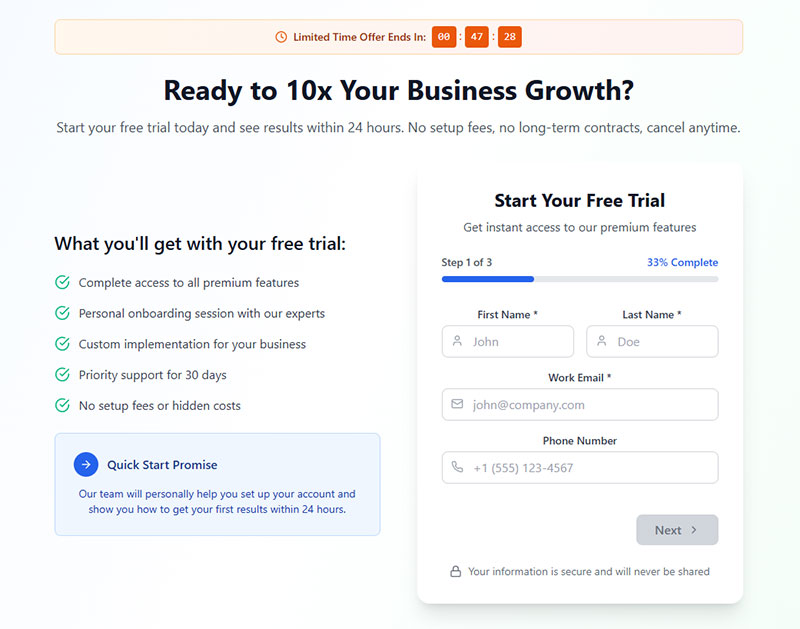
Single-purpose design eliminates distractions. Remove navigation menus, social media links, and sidebar content. Focus entirely on form completion.
The standard conversion rate for landing pages across various sectors is 9.7%, but the average conversion rate across all industries is 2.9%. Every element should support conversion. Use white space strategically to guide attention toward your form.
Remove navigation to prevent departures. Visitors came for specific offers advertised in your marketing campaigns. Keep them focused on that goal.
84% of marketers use the form submission method to generate leads, making optimization crucial for success.
Match messaging to traffic source for consistency. Facebook ad visitors expect different language than Google search traffic. Align form headlines with advertisement copy.
Speed matters in lead conversion. Answering in under five minutes can elevate conversion rates by a remarkable nine times. Test message matching across all traffic sources. Small alignment improvements create significant conversion gains.
Form Placement: Above vs Below the Fold
Placing forms too early can increase exit rates if visitors feel pressed to share information before being given proper context. However, strategic above-fold placement works for simple offers.
A study by Nielsen Group found that regardless of screen size, the average difference in how users treat info above vs. below-the-fold is 84 percent.
Above-the-fold works when:
- Product or service is simple and self-explanatory
- Visitors arrive from targeted campaigns already familiar with your brand
- Free trials or low-commitment offers
Below-the-fold performs better for:
- Complex products requiring detailed explanations
- High-value purchases needing trust-building content
- Professional services like law firms or consultancies
One case study showed placing the call to action at the bottom of a very long landing page increased conversions by 304%. The key is providing valuable content that convinces visitors to scroll and engage.
Advanced Form Optimization Tactics
Multi-step forms reduce psychological barriers while collecting more information. Multistep popups can improve the conversion rate to 4% compared to single-step alternatives.
Countdown timers create urgency and drive action. Popups with countdown timers average a 14.41% conversion rate, compared to 9.86% without them.
Social proof integration builds trust and credibility. Include testimonials, customer counts, or trust badges near your forms to reduce hesitation.
Research indicates that 63% of those reaching out need more time to commit, making nurturing strategies essential for long-term success.
Testing and optimization remains the only definitive way to determine optimal form placement. Use website platforms with easy editing and built-in split testing, and experiment by shifting forms above and below the fold.
The most successful businesses combine strategic placement with continuous testing to find what works best for their specific audience and industry.
Designing High-Converting Form Layouts
Design drives decisions. Beautiful forms convert better than functional-but-ugly alternatives.
Nearly 50% of marketers agree that web forms are their highest converting lead generation tool, yet only 38% of users who interact with a contact form end up successfully submitting their details. This stark gap shows exactly why form design matters so much.
Form Length and Field Selection

Optimal field numbers vary by offer value. High-value lead magnets justify longer forms. Free guides might need only email addresses.
The average number of form fields is 5, but this doesn’t mean five works for everyone. Over 30% of marketers say they get the highest conversion rates from forms with 4 fields. More dramatic is this finding: reducing a form from 4 fields to 3 can increase conversion rate by almost 50%.
Test field reduction systematically. Remove one field at a time and measure conversion impact.
Required versus optional strategies balance conversion with data collection. Mark essential fields clearly with asterisks. Make optional fields obviously voluntary.
Phone numbers often reduce conversions. Their respective abandonment rates are 6.4% (email) and 6.3% (phone number). Test whether you actually need them for your follow-up process.
Progressive profiling collects information gradually. Show different fields to returning visitors. Build detailed customer profiles over multiple interactions.
Use conditional logic to personalize experiences. Show relevant questions based on previous answers.
Visual Design Elements That Increase Conversions
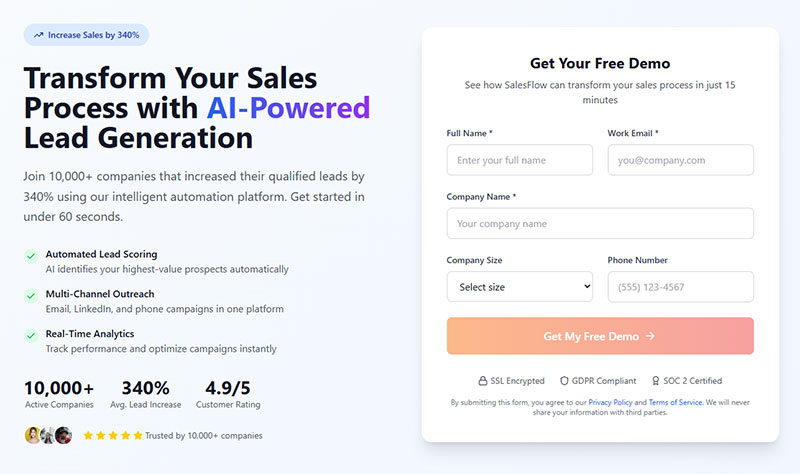
Button optimization impacts results dramatically. Test colors, sizes, and shapes extensively. Changing the color of the CTA button can increase conversions by 21%. Red and orange buttons often outperform blue ones for consumer brands.
Increasing the size of the CTA button can increase click-through rates by 90%. Make buttons large enough for mobile tapping. Small buttons frustrate smartphone users.
Form spacing improves completion rates. Add generous white space between fields. Maintaining balance throughout the page and giving your CTAs a little room to breathe can improve conversion rates by 232%. Cramped forms feel overwhelming and unprofessional.
Use consistent spacing throughout your design. Align elements properly for visual harmony.
Mobile-responsive design isn’t optional anymore. Mobile usage dominates retail usage (approximately 70% to 30%). Yet conversion rates tend to be significantly higher on desktop (1.7 X) compared to smartphone. Your mobile forms must work perfectly on small screens.
The view to starter rate for desktop is 47% compared to 42% for mobile. Test forms on actual devices. Emulators miss real-world usability issues.
Trust signals reduce abandonment fears. Display security badges, testimonials, and privacy statements near forms. Show customer logos if you have recognizable clients.
Explain data usage clearly. Privacy concerns stop many people from submitting personal information.
Form Copy and Messaging
Compelling headlines grab attention immediately. Focus on benefits rather than features. “Get Your Free Marketing Guide” beats “Download Our PDF.”
Test emotional versus logical appeals. Consumer audiences often respond better to emotional triggers.
Value propositions must be crystal clear. Explain exactly what people receive for their information. Vague promises reduce conversion rates significantly.
Use specific numbers and timeframes. “7 proven strategies” sounds more valuable than “helpful tips.”
Action-oriented button text encourages clicks. Using a specific, clear CTA can increase conversion rates by 161%. Use first-person language like “Send Me My Guide” instead of generic commands. Personal language feels more engaging.
Privacy messaging addresses growing concerns. Include brief statements about data protection near your forms. Link to detailed privacy policies for transparency.
GDPR compliance requires explicit consent. Add checkboxes for email permissions when necessary. Make consent language simple and clear.
Advanced Design Considerations
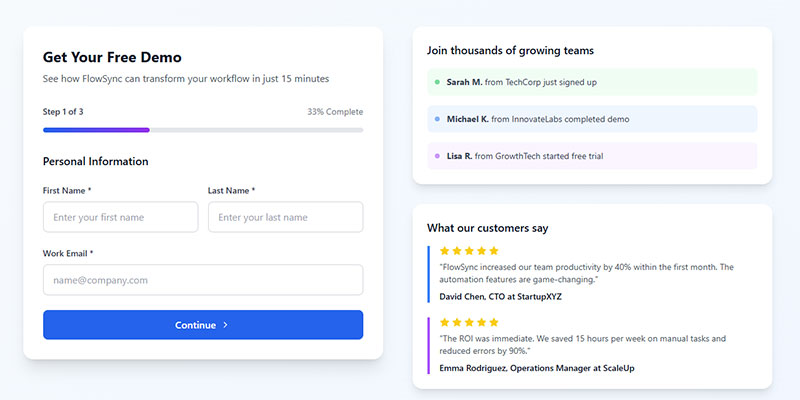
Multi-step forms reduce perceived complexity. Only 40% of marketers use multi-step forms but their conversion rate is 86% higher. Break long forms into smaller sections. Show progress indicators to maintain momentum.
Single-step forms work better for simple offers. Don’t complicate easy decisions unnecessarily.
Error messaging prevents frustration. Use form validation to catch mistakes immediately. The password field has a mean abandonment rate of 10.5%, significantly higher than the rest. Provide helpful correction suggestions rather than generic error notices.
Auto-fill capabilities speed completion. Using autofill in forms can increase conversion rate by more than 10%. Enable browser auto-complete features. Smart defaults reduce typing requirements significantly.
Social proof integration builds confidence. Show recent signup numbers or customer testimonials near forms. Real-time activity notifications create urgency.
Test different proof elements. Some audiences prefer statistics while others respond to testimonials.
Critical Performance Factors
Page loading speed kills conversions instantly. A one-second delay in page load time can result in a 7% reduction in conversions. Even worse, 53% of mobile site visitors will leave a page that takes longer than three seconds to load.
Form abandonment remains a massive problem. 81% of people have abandoned at least one web form, and over 80% of shoppers abandon booking and checkout forms. But there’s hope: 20% of partial form responders will come back and complete the form if they are sent a link to the incomplete form.
A/B testing drives measurable improvements. Marketers who run A/B tests on their forms report conversion rates that are 10% higher on average than those who don’t use split tests. Yet shockingly, 36% of marketers never run user tests on their forms.
Industry Performance Benchmarks
Form conversion rates vary dramatically by industry:
- Top performers: Industrial (2.8%), professional services (2.5%), and B2B services (2.2%)
- Challenging sectors: Real estate (0.6%), B2B eCommerce (0.7%), and B2C eCommerce (0.8%)
The average form conversion rate across all industries is 1.7%. This means the average conversion rate for a landing page is around 6.6% across all industries as of Q4 2024, but form-specific conversions remain much lower.
Understanding these benchmarks helps set realistic expectations and identify improvement opportunities for your specific industry and use case.
Creating Irresistible Lead Magnets
Weak lead magnets kill conversions. Strong ones build customer pipelines that generate revenue for years.
50% of marketers report seeing higher conversion rates when using lead magnets, making them critical tools for building profitable sales funnels. The average lead magnet landing page converts at a rate of 18%, but top performers achieve much higher results.
Types of Lead Magnets for B2C Audiences
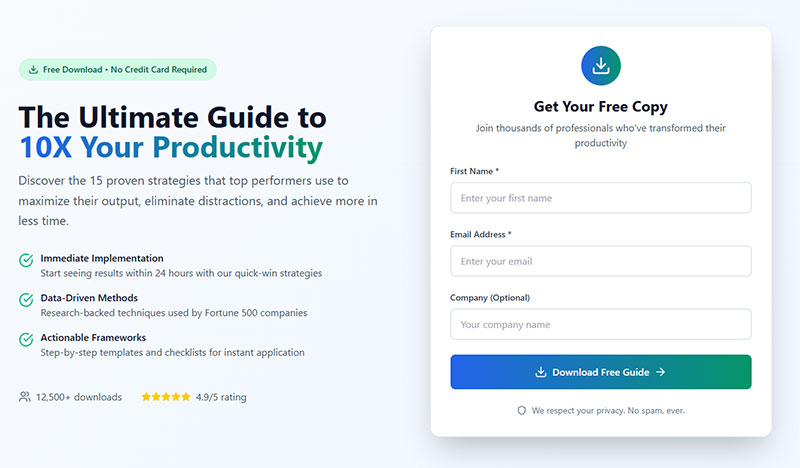
Free guides and ebooks work across all consumer segments. Ebooks are the most popular lead magnet, with 27.7% of marketers using them. Create actionable content that solves immediate problems. “10 Budget Recipes for Busy Parents” performs better than generic cooking guides.
Keep guides short and scannable. 58.6% of marketers say short-form written content had the highest conversion rates. Busy consumers want quick wins, not lengthy manuals. For better conversion, keep your ebook lead magnets less than 30 pages. The average ebook lead magnet is between 5,000 and 10,000 words long.
Exclusive discount codes drive immediate action. Offer 10-15% savings for first-time buyers. Time-limited offers create urgency that boosts conversion rates significantly.
Almost everyone is always on the lookout for discounts. This explains why consumers prefer brands with the most attractive discounts and specials when purchasing. Coupon pages work perfectly because the benefit is obvious—the discount.
Test different discount percentages. Higher discounts don’t always produce better results if they damage profit margins.
Product samples and trials let customers experience value firsthand. Beauty brands excel with sample kits. Software companies offer free trial periods. Physical samples work especially well for consumable products.
Opt-out trials (payment info required) achieve a stellar 48.8% conversion rate! Users are more invested, but the barrier to entry is higher. B2C trials generally have higher conversion rates, but B2B trials can lead to bigger fish (and higher customer lifetime value) in the long run.
Webinar and event access builds authority while generating leads. Webinars resulted with the highest conversion rate (70.2%) based on a survey of 111 marketers. The average webinar has a conversion rate of 55%.
Live webinars are the leader in lead generation, accounting for 89% of leads compared to just 11% from on-demand options. Live events create community feelings. Recorded sessions provide ongoing value for busy schedules.
Promote exclusive access. People want insider information they can’t get elsewhere.
Quizzes and assessments engage audiences actively. “What’s Your Skincare Type?” generates leads while providing personalized recommendations. Interactive content performs better than static downloads.
Create quiz results that feel valuable. Generic outcomes disappoint participants and reduce sharing.
Matching Lead Magnets to Customer Segments
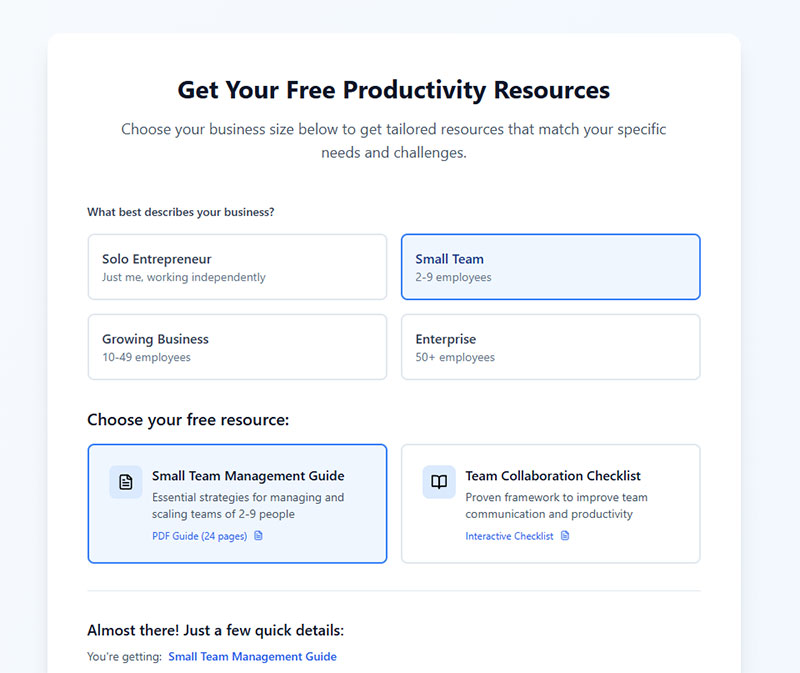
Demographic-based selection targets specific groups effectively. Young parents need time-saving solutions. Retirees prefer detailed explanations and step-by-step guidance.
The highest conversion rates for text-based lead magnets were seen in organizations with 2-9 employees (17.6%), 10-49 employees (8.2%), and 50-249 employees (6.7%). Different business sizes respond to different approaches.
Research your audience thoroughly. Survey existing customers about their biggest challenges and preferred content formats.
Interest-based content aligns with browsing behavior. Fitness blog readers want workout plans. Home improvement visitors prefer DIY guides. Match magnets to content consumption patterns.
Video content is the preferred lead magnet type among solopreneurs, who account for 60% of study participants. Companies with 10-49 employees saw the same results. For all the other groups, businesses with 2-9 (17.6%), 50-249 (6.7%), and 250+ employees (7.5%), text-based lead magnets had the highest conversion rates.
Track which pages generate the most engagement. Create lead magnets that extend popular content topics.
Purchase stage-appropriate incentives move prospects forward. Awareness stage visitors need educational content. Consideration stage prospects want comparison guides. Decision stage buyers respond to discount codes.
Map lead magnets to customer journey stages. Different touchpoints require different approaches.
Creating Urgency and Scarcity
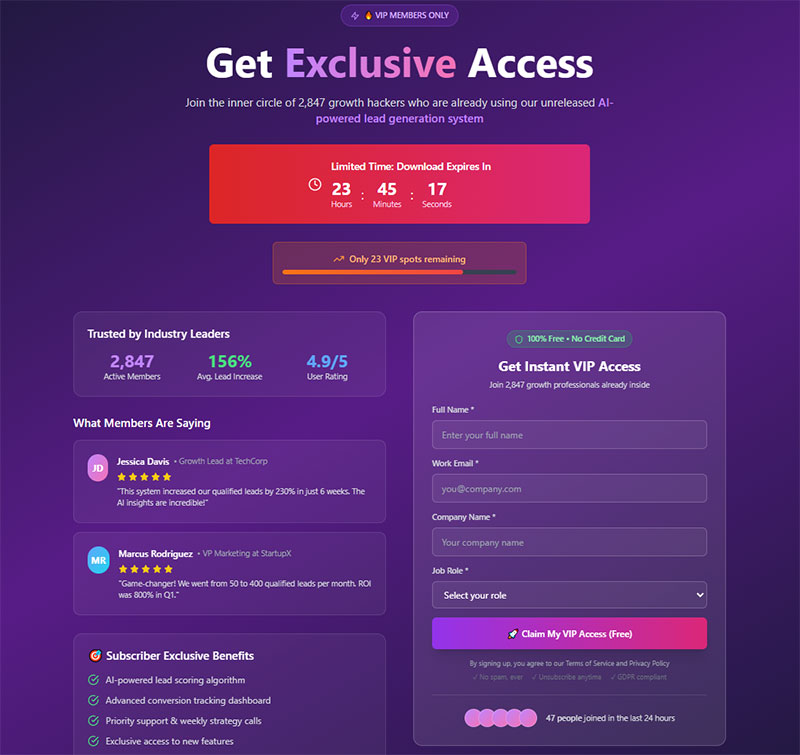
Limited-time offers motivate immediate action. “Download expires in 24 hours” creates pressure without being pushy. Use countdown timers for visual impact.
Social proof notifications can even increase conversions by 17% when integrated as a lead magnet strategy. FOMO is the same underlying psychology behind consumers purchasing products based on online research on what is trending or new.
Exclusive access messaging makes people feel special. “VIP members only” or “Subscriber exclusive” language appeals to status desires.
Stock availability indicators work for physical products. “Only 50 sample kits remaining” encourages quick decisions. Real scarcity converts better than fake urgency.
Peer recommendation is trusted by 92% of consumers, making social proof notifications powerful conversion tools. A social proof notification is a tiny pop-up window on special offers or product sales that appear on a website in real-time to consumer engagements.
Performance Benchmarks and Optimization
Top-performing lead magnet types show clear patterns:
- Video (24.2%) and Written (22.8%) were picked by 47% of respondents as the most popular formats
- Cheat sheet landing pages average 34% conversion rates, with top performers reaching 66%
- Guide books (67.2%) help businesses generate the highest conversion rate in long-form written content
- E-book samples help businesses generate the highest conversion rate in short-form written content according to 55.9% of respondents
Timing and frequency matter significantly:
- Tuesdays, Wednesdays, and Thursdays are more likely to see higher conversion rates from poll responses and downloads
- 90-minute webinars achieve the highest attendance at 72%, followed by 45-minute webinars at 47%
- January is the top month for webinar attendance, with live attendance rates reaching 50% – the highest of any month
Cost-effectiveness drives ROI:
- With an average cost per lead of $72, webinars are a cost-effective alternative to traditional channels like trade shows or PPC advertising, which can cost upwards of $150 per lead
- 75% of marketers said webinars lowered their cost-per-lead
- One well-designed lead magnet funnel generated 45% of a company’s 2024 revenue, with a 2.7x conversion rate increase and 34% higher average contract values
The data proves that strategic lead magnet selection and optimization directly impact business results. Focus on formats that match your audience preferences, test timing variations, and track performance metrics to build sustainable lead generation systems.
Technical Implementation and Form Functionality
Technical problems destroy conversions instantly. Perfect forms need solid foundations.
Form Builder Tools and Platforms
Popular software options simplify creation without coding knowledge. HubSpot provides comprehensive marketing automation. Mailchimp integrates email campaigns seamlessly. ConvertKit specializes in creator businesses.
WordPress contact form plugins offer affordable solutions. Many free WordPress form plugins handle basic lead capture effectively.
Choose tools that grow with your business. Switching platforms later causes data migration headaches.
Email marketing platform integration automates follow-up sequences. Direct connections prevent manual data entry. API integrations sync information in real-time.
Test integration reliability. Broken connections lose leads permanently.
CRM connection setup centralizes customer management. Salesforce handles enterprise needs. Smaller businesses often prefer HubSpot or Pipedrive for simplicity.
Clean data improves sales team efficiency. Standardize field formats before connecting systems.
Form Validation and User Experience
Real-time field validation catches errors immediately. Highlight problems as users type rather than after submission. Instant feedback reduces frustration and abandonment.
Email validation prevents typos that break follow-up campaigns. Phone number formatting ensures dialable contacts.
Clear error messaging guides corrections effectively. “Please enter a valid email address” helps more than generic “Error in field 2” messages.
Use friendly language in error messages. Harsh tones discourage completion attempts.
Auto-fill and smart defaults speed completion. Enable browser auto-complete features. Pre-populate known information for returning visitors.
Country and state dropdowns should default to your primary market. Most visitors come from predictable locations.
Multi-step form implementation breaks complex processes into manageable pieces. Show progress indicators to maintain momentum. Save partial completions to reduce restart frustration.
Multi-step forms work well for high-value offers. Simple email captures rarely need multiple steps.
Mobile Optimization Requirements
Touch-friendly elements accommodate finger navigation. Make buttons large enough for easy tapping. Space fields adequately to prevent accidental selections.
Test forms on actual mobile devices. Desktop emulators miss real usability issues.
Simplified mobile layouts reduce cognitive load. Stack fields vertically. Minimize horizontal scrolling. Use large, readable fonts.
Mobile users have shorter attention spans. Remove non-essential fields from mobile versions.
Fast loading times prevent abandonment. Optimize images and minimize scripts. Mobile users abandon slow pages within seconds.
Test loading speeds on 3G connections. Not everyone has high-speed internet access.
Advanced Technical Considerations
Form security protects sensitive data. Use HTTPS connections for all form submissions. Implement CAPTCHA systems to prevent spam while maintaining user experience.
Form security becomes more critical as data breaches increase. Regular security audits identify vulnerabilities early.
Database integration stores information reliably. Choose hosting providers with robust backup systems. Test data recovery procedures before you need them.
Analytics tracking measures performance accurately. Google Analytics tracks form completion events. Heat mapping tools show where users struggle or abandon forms.
Set up conversion goals properly. Accurate measurement enables effective optimization.
A/B testing infrastructure enables continuous improvement. Test one element at a time for clear results. Document all changes to avoid repeating failed experiments.
Statistical significance matters. Run tests long enough to generate reliable data before making permanent changes.
Testing and Optimizing Form Performance
Data beats guesswork. Test everything systematically.
A/B Testing Form Elements
Testing different form lengths reveals optimal field counts. Start with minimal fields and add one at a time. Track conversion drops at each addition.
Three-field forms often outperform longer versions for consumer offers. Name, email, and phone capture essential contact information without overwhelming visitors.
Button variations impact results dramatically. Test colors, sizes, text, and positioning separately. Red buttons frequently outperform blue ones in consumer markets.
“Get My Free Guide” converts better than generic “Submit” text. First-person language feels more personal and engaging.
Form placement experiments identify optimal positions. Test above-fold versus below-fold positioning. Compare sidebar forms against inline placement throughout content.
Exit intent popup timing affects performance significantly. Test immediate triggers versus 30-second delays.
Lead magnet offer comparisons determine audience preferences. Test discount codes against free content. Compare specific guides versus general resources.
Personalized offers based on browsing behavior often outperform generic incentives.
Analyzing Form Analytics
Identifying abandonment points pinpoints problem areas. Track where users stop completing forms. High abandonment at specific fields indicates issues.
Google Analytics funnel reports show detailed dropout patterns. Heat mapping tools reveal user interaction problems.
Traffic source performance varies significantly. Social media visitors behave differently than search traffic. Email subscribers convert better than cold traffic.
Facebook ads often generate lower-quality leads than Google searches. Adjust follow-up sequences accordingly.
Device and browser conversion rates highlight technical issues. Mobile forms might underperform due to design problems. Specific browsers may display formatting incorrectly.
Test forms across all major browsers and devices regularly. Safari handles some form elements differently than Chrome.
Continuous Improvement Strategies
Regular performance reviews maintain optimization momentum. Schedule monthly conversion rate audits. Compare current performance against historical baselines.
Seasonal patterns affect form performance. Holiday shopping periods change consumer behavior significantly.
User feedback collection provides qualitative insights. Survey form abandoners about their experience. Ask customers what nearly prevented them from signing up.
Website feedback survey questions help identify usability problems analytics miss.
Seasonal adjustments accommodate changing behavior. Back-to-school periods favor educational content. Holiday seasons boost discount code effectiveness.
Legal Compliance and Data Protection
Privacy regulations carry serious penalties. Compliance protects both customers and businesses.
GDPR and Privacy Regulation Compliance

Consent checkbox requirements ensure explicit permission. Pre-checked boxes violate GDPR rules. Users must actively opt into data collection.
Consent language must be clear and specific. “I agree to receive marketing emails” beats vague “I accept terms and conditions” statements.
Clear privacy policy links provide transparency. Position links prominently near consent checkboxes. Write policies in plain language consumers understand.
GDPR compliant forms require specific design elements. Cookie notices, data processing explanations, and withdrawal instructions are mandatory.
Data processing explanations detail information usage. Explain why you collect each field. Describe how long you store personal data.
Right to deletion requests require systematic response procedures. Implement easy data removal processes.
Email Marketing Compliance
Double opt-in implementation confirms genuine interest. Send confirmation emails after initial signup. Only add confirmed subscribers to marketing lists.
Single opt-in generates more leads but risks deliverability problems. Double opt-in produces higher-quality subscribers.
Unsubscribe link requirements enable easy removal. Include prominent unsubscribe options in every marketing email. Process removal requests within 10 days.
Anti-spam law adherence varies by jurisdiction. CAN-SPAM requires physical addresses in emails. European regulations are stricter than US requirements.
Monitor blacklist status regularly. Poor list hygiene damages sender reputation permanently.
Data Security Best Practices
Secure transmission protocols protect sensitive information. Use HTTPS connections for all form submissions. SSL certificates encrypt data during transfer.
Database protection measures prevent unauthorized access. Regular backups protect against data loss. Access controls limit who can view personal information.
Regular security audits identify vulnerabilities early. Penetration testing reveals potential breach points. Update software promptly to patch security holes.
Form security becomes more critical as cyber threats increase. Implement multi-factor authentication for admin accounts.
International Compliance Considerations
Regional regulation differences require specific approaches. California’s CCPA grants deletion rights similar to GDPR. Canadian PIPEDA has unique consent requirements.
Cross-border data transfer restrictions limit storage options. EU data often cannot be stored on US servers without specific safeguards.
Industry-specific requirements add complexity. Healthcare forms need HIPAA compliance. Financial services require additional security measures.
Implementation Best Practices
Legal review processes ensure proper compliance. Have attorneys review privacy policies and consent language. Update policies when regulations change.
Staff training programs maintain consistent practices. Train customer service teams on data handling procedures. Document all privacy-related processes clearly.
Incident response plans prepare for potential breaches. Notify authorities within required timeframes. Communicate transparently with affected customers.
Compliance monitoring tracks regulatory changes. Privacy laws evolve frequently. Subscribe to legal updates in your operating jurisdictions.
Regular compliance audits prevent expensive violations. Prevention costs less than penalty payments.
Following Up with Form Submissions
Speed matters. Delayed responses kill conversion momentum.
Immediate Response Strategies
Thank you page optimization confirms successful submission while maintaining engagement. Display clear confirmation messages and next steps. Redirect users to relevant content instead of generic success pages.
Customize messages based on lead magnet type. Download confirmations differ from consultation requests.
Confirmation email templates should arrive within minutes. Automated delivery prevents delays. Include download links, account access information, or appointment details immediately.
Registration successful message examples show effective confirmation approaches. Personal touches increase satisfaction and reduce buyer’s remorse.
Instant lead magnet delivery meets immediate expectations. Host downloads on reliable servers. Broken links frustrate new subscribers and damage first impressions.
Test delivery systems regularly. Monitor email deliverability rates across different providers.
Email Nurturing Sequences
Welcome email series builds relationships systematically. Send educational content before promotional material. Space emails 2-3 days apart to avoid overwhelming subscribers.
First emails set relationship tone. Focus on value delivery rather than sales pitches.
Educational content delivery establishes expertise while warming prospects. Share industry insights, how-to guides, and customer success stories. Mix content formats to maintain interest.
Product promotion timing requires careful balance. Introduce offers after providing substantial value. Track engagement metrics to identify optimal timing for each audience segment.
Sales Team Handoff Processes
Lead scoring prioritizes follow-up efforts. Assign points for form completions, email opens, and website behavior. Hot leads need immediate attention.
CRM integration workflows automate lead distribution. Route high-value prospects to senior sales reps. Geographic territories determine assignment for local businesses.
Follow-up timing affects conversion dramatically. Contact form submissions within 5 minutes convert 9x better than hour-delayed responses.
Measuring Success and ROI
Numbers reveal truth. Track what matters.
Key Performance Indicators
Form conversion rates by traffic source show channel effectiveness. Google Ads might convert at 12% while Facebook traffic converts at 4%. Organic search typically produces highest-quality leads.
Social media generates volume but often lower intent. Email subscribers convert 3-5x better than cold traffic.
Lead-to-customer conversion rates measure downstream success. Track how many form submissions become paying customers. B2C rates typically range 2-5% depending on industry and price points.
E-commerce sees higher conversion rates than service businesses. Physical products convert faster than consulting services.
Customer lifetime value from form leads determines true ROI. Calculate average purchase amounts and repeat buying patterns. High CLV justifies higher acquisition costs.
Segment CLV by lead source. Email newsletter subscribers often have 25% higher lifetime value than social media leads.
Cost Analysis and Budget Planning
Form optimization investment costs include tools, design, and testing time. Basic form builders cost $20-100 monthly. Enterprise solutions reach $500+ for advanced features.
Factor in staff time for testing and optimization. Proper A/B testing requires dedicated resources.
Lead generation cost per acquisition varies dramatically by industry. B2C averages $25-75 per lead through forms. Premium products justify higher costs.
ROI calculation methods measure profitability accurately:
- Simple ROI: (Revenue – Costs) / Costs × 100
- Customer Acquisition Cost: Total marketing spend / New customers acquired
- Payback Period: Time to recover acquisition investment
Track both immediate and long-term returns. Some leads convert months after initial contact.
Reporting and Performance Tracking
Monthly form performance reports maintain optimization momentum. Monitor conversion trends, traffic sources, and lead quality metrics.
Create automated dashboards using Google Analytics and CRM data. Manual reporting wastes valuable time.
Year-over-year growth analysis reveals seasonal patterns and long-term trends. Holiday periods often boost consumer form conversions 15-30%.
Compare performance against industry benchmarks. Marketing automation platforms provide sector-specific data.
Competitive benchmarking identifies improvement opportunities. Monitor competitor lead magnets and form strategies. Tools like SEMrush reveal their top-performing landing pages.
Advanced Analytics Considerations
Attribution modeling credits multiple touchpoints appropriately. First-click attribution differs from last-click models significantly. Most B2C customers require 3-7 touchpoints before converting.
Cohort analysis tracks subscriber value over time. Month 1 subscribers might show different patterns than Month 6 cohorts. Seasonal signups often behave differently.
Funnel analysis identifies optimization opportunities. Track the complete journey from form view to customer conversion. Small improvements compound significantly.
Budget Allocation Strategies
Testing budget allocation should represent 10-20% of total form marketing spend. Continuous optimization requires dedicated resources.
Tool and platform costs scale with business growth. Start with affordable solutions and upgrade as volume increases.
Staff training investments improve long-term performance. Form optimization skills provide ongoing value across all marketing channels.
FAQ on How To Generate B2C Leads
What’s the optimal number of form fields for B2C lead capture?
Three to five fields maximize conversions. Request name, email, and phone number for basic lead capture. Additional fields like company size or interests reduce completion rates. Lead capture forms with fewer fields convert 25% better than longer alternatives.
How do I create compelling lead magnets for consumer audiences?
Offer immediate value through discount codes, free guides, or exclusive content. Match magnets to customer pain points. “10 Budget Recipes” outperforms generic cooking guides. Time-sensitive offers create urgency that boosts conversion rates significantly.
Where should I place forms on my website for maximum conversions?
Test above-fold homepage placement, sidebar integration, and end-of-content positioning. Exit-intent popups capture departing visitors effectively. Product page forms near descriptions convert during peak purchase intent. Multiple strategic placements outperform single form placement.
What makes mobile forms convert better than desktop versions?
Touch-friendly buttons, simplified layouts, and fast loading times drive mobile conversions. Stack fields vertically and increase button sizes. Auto-fill capabilities reduce typing friction. Mobile users abandon slow forms within seconds.
How quickly should I follow up with form submissions?
Contact leads within 5 minutes for 9x better conversion rates. Automated confirmation emails should arrive immediately. Welcome sequences starting within hours maintain engagement momentum while leads remain hot and interested.
What A/B testing elements improve form performance most?
Test button colors, form length, headline copy, and lead magnet offers systematically. Red buttons often outperform blue alternatives. “Get My Free Guide” converts better than generic “Submit” text. Single-element tests provide clearest optimization insights.
How do I ensure forms comply with privacy regulations?
Include explicit consent checkboxes, clear privacy policy links, and data usage explanations. GDPR compliant forms require unambiguous consent language. Double opt-in processes confirm genuine subscriber interest while meeting regulatory requirements.
What’s the difference between contact forms and lead generation forms?
Contact forms or lead generation forms serve different purposes. Contact forms handle customer service inquiries. Lead generation forms capture prospects through valuable offers. Lead forms include compelling incentives while contact forms focus on problem resolution.
How do I reduce form abandonment rates?
Implement real-time validation, clear error messaging, and progress indicators. Remove unnecessary fields and add trust signals. Improving form abandonment rate requires systematic user experience optimization and mobile-friendly design.
What tools work best for creating high-converting B2C forms?
HubSpot, Mailchimp, and ConvertKit offer comprehensive solutions. WordPress lead generation plugins provide cost-effective alternatives. Choose platforms with email marketing integration, analytics tracking, and mobile optimization features built-in.
Conclusion
Mastering how to generate B2C leads using website forms requires strategic planning and continuous optimization. Consumer audiences demand seamless user experiences across all devices.
Success depends on key elements:
- Form design that prioritizes mobile responsiveness
- Analytics tracking through Google Analytics and heat mapping
- Email marketing integration with platforms like HubSpot and Mailchimp
- Progressive profiling that builds customer data gradually
Marketing automation streamlines follow-up sequences while lead scoring prioritizes high-value prospects. Regular A/B testing reveals optimization opportunities that compound over time.
Customer acquisition costs decrease when forms convert efficiently. Database management and CRM integration ensure leads receive proper nurturing through the sales pipeline.
Start implementing these strategies immediately. Monitor conversion metrics closely and adjust based on performance data. Effective lead generation transforms casual website visitors into valuable customer relationships that drive long-term revenue growth.
